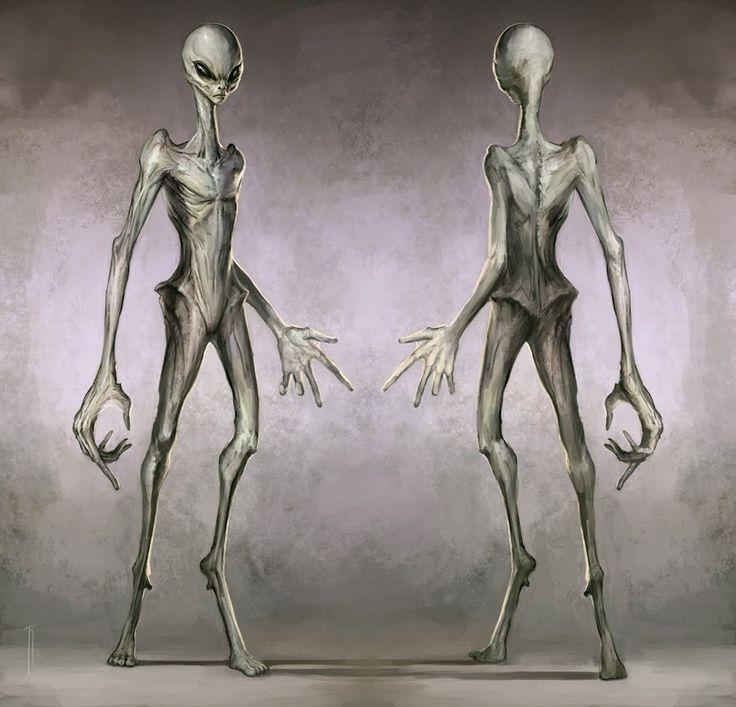
What do aliens look like?
Do we have reason and right to expect Aliens to be like us? It may turn out that they are more similar to our ancestors. Great-great and many times great, ancestors.
Matthew Wills, a paleobiologist at the University of Bath in the UK, was recently tempted to consider the possible body structure of possible extrasolar planet dwellers. In August of this year, he recalled in the journal phys.org that during the so-called. During the Cambrian explosion (the sudden flowering of aquatic life about 542 million years ago), the physical structure of organisms was extremely diverse. At that time, for example, lived opabinia - an animal with five eyes. Theoretically, it is possible to deduce a reasonable species with just such a number of organs of vision. In those days, there was also a flower-like Dinomis. What if Opabinia or Dinomischus had reproductive and evolutionary success? So there is reason to believe that aliens can be diametrically different from us, and at the same time be close in some way.
Completely different views on the possibility of life on exoplanets collide. Someone would like to see life in space as a universal and diverse phenomenon. Others warn of over-optimism. Paul Davies, a physicist and cosmologist at Arizona State University and author of The Eerie Silence, thinks that the abundance of exoplanets can mislead us, since the statistical probability of the random formation of life molecules remains negligible even with a large number of worlds. Meanwhile, many exobiologists, including those from NASA, believe that not so much is needed for life - all that is needed is liquid water, an energy source, some hydrocarbons and a little time.
But even the skeptic Davis eventually admits that considerations of improbability do not concern the possibility of the existence of what he calls shadow life, which is based not on carbon and protein, but on completely different chemical and physical processes.
Live silicon?
In 1891, the German astrophysicist Julius Schneider wrote that life does not have to be based on carbon and its compounds. It could also be based on silicon, an element in the same group on the periodic table as carbon, which, like carbon, has four valence electrons and is much more resistant than it to the high temperatures of space.
The chemistry of carbon is mostly organic, because it is part of all the basic compounds of "life": proteins, nucleic acids, fats, sugars, hormones and vitamins. It can proceed in the form of straight and branched chains, in the form of cyclic and gaseous (methane, carbon dioxide). After all, it is carbon dioxide, thanks to plants, that regulates the carbon cycle in nature (not to mention its climatic role). Organic carbon molecules exist in nature in one form of rotation (chirality): in nucleic acids, sugars are only dextrorotatory, in proteins, amino acids - levorotatory. This feature, which has not yet been explained by researchers of the prebiotic world, makes carbon compounds extremely specific for recognition by other compounds (for example, nucleic acids, nucleolytic enzymes). The chemical bonds in carbon compounds are stable enough to ensure their longevity, but the amount of energy of their breaking and formation ensures metabolic changes, decomposition and synthesis in a living organism. In addition, carbon atoms in organic molecules are often linked by double or even triple bonds, which determines their reactivity and the specificity of metabolic reactions. Silicon does not form polyatomic polymers, it is not very reactive. The product of silicon oxidation is silica, which takes a crystalline form.
Silicon forms (like silica) permanent shells or internal "skeletons" of some bacteria and unicellular cells. It does not tend to be chiral or create unsaturated bonds. It is simply too chemically stable to be the specific building block of living organisms. It has proven to be very interesting in industrial applications: in electronics as a semiconductor, as well as an element that creates high-molecular compounds called silicones used in cosmetics, parapharmaceuticals for medical procedures (implants), in construction and industry (paints, rubbers). , elastomers).
As you can see, it is not a coincidence or a whim of evolution that earthly life is based on carbon compounds. However, to give silicon a little chance, it was hypothesized that in the prebiotic period it was on the surface of crystalline silica that particles with opposite chirality separated, which helped in the decision to choose only one form in organic molecules. .
Supporters of "silicon life" argue that their idea is not at all absurd, because this element, like carbon, creates four bonds. One concept is that silicon can create parallel chemistry and even similar life forms. Renowned astrochemist Max Bernstein of NASA Research Headquarters in Washington DC points out that perhaps the way to find silicon extraterrestrial life is to look for unstable, high-energy silicon molecules or strings. However, we do not encounter complex and solid chemical compounds based on hydrogen and silicon, as is the case with carbon. Carbon chains are present in lipids, but similar compounds involving silicon will not be solid. While compounds of carbon and oxygen can form and break apart (as they do in our bodies all the time), silicon is different.
The conditions and environments of the planets in the universe are so varied that many other chemical compounds would be the best solvent for a building element under conditions different from those we know on Earth. It is likely that organisms with silicon as a building block will exhibit much longer lifespans and resistance to high temperatures. However, it is not known whether they will be able to pass through the stage of microorganisms into organisms of a higher order, capable, for example, of the development of reason, and hence of civilization.
There are also ideas that some minerals (not just those based on silicon) store information - like DNA, where they are stored in a chain that can be read from one end to the other. However, the mineral could store them in two dimensions (on its surface). Crystals "grow" when new shell atoms appear. So if we grind the crystal and it starts to grow again, it will be like the birth of a new organism, and information can be passed on from generation to generation. But is the reproducing crystal alive? To date, no evidence has been found that minerals can transmit "data" in this way.
pinch of arsenic
Not only silicon excites non-carbon life enthusiasts. A few years ago, reports of NASA-funded research at Mono Lake (California) made a splash about the discovery of a bacterial strain, GFAJ-1A, that uses arsenic in its DNA. Phosphorus, in the form of compounds called phosphates, builds, among other things. The backbone of DNA and RNA, as well as other vital molecules such as ATP and NAD, are essential for energy transfer in cells. Phosphorus seems indispensable, but arsenic, next to it in the periodic table, has very similar properties to it.
Aliens from the "War of the Worlds" - visualization
The aforementioned Max Bernstein commented on this, cooling his enthusiasm. “The result of the California studies was very interesting, but the structure of these organisms was still carbonaceous. In the case of these microbes, arsenic replaced phosphorus in the structure, but not carbon, ”he explained in one of his statements to the media. Under the various conditions prevailing in the universe, it cannot be ruled out that life, so highly adaptable to its environment, could have developed on the basis of other elements, and not silicon and carbon. Chlorine and sulfur can also form long molecules and bonds. There are bacteria that use sulfur instead of oxygen for their metabolism. We know many elements that, under certain conditions, could better than carbon serve as a building material for living organisms. Just like there are many chemical compounds that can act like water somewhere in the universe. We must also remember that there are likely to be chemical elements in space that have not yet been discovered by man. Perhaps, under certain conditions, the presence of certain elements can lead to the development of such advanced life forms as on Earth.
Aliens from the movie "Predator"
Some believe that the aliens we may encounter in the universe will not be organic at all, even if we understand organics in a flexible way (i.e. take into account chemistry other than carbon). It could be…artificial intelligence. Stuart Clark, author of The Search for the Earth's Twin, is one of the proponents of this hypothesis. He emphasizes that taking into account such contingencies would solve many problems - for example, adaptation to space travel or the need for the "right" conditions for life.
No matter how bizarre, full of sinister monsters, cruel predators and technologically advanced big-eyed aliens, our ideas about the potential inhabitants of other worlds may have been, so far in one way or another associated with the forms of people or animals known to us from Earth. It seems that we can only imagine what we associate with what we know. So the question is, can we also notice only such aliens, somehow connected with our imagination? This can be a major problem when we are faced with something or someone "completely different".
We invite you to familiarize yourself with the Topic of the issue in.

